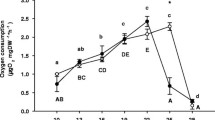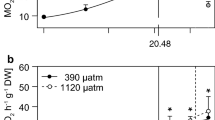Abstract
Understanding thermal limits and the ability of species to cope with changing temperatures is crucial for a cause and effect understanding of climate effects on organisms and ecosystems. Data available for marine species from various phyla and climates led to the hypothesis that a mismatch between oxygen demand and limited capacity of oxygen supply to tissues is the first mechanism to restrict survival at thermal extremes. Here we show that doubling the oxygen content of the ambient seawater from 160 mmHg partial pressure to 350 mmHg raised the upper temperature limits of the Antarctic marine bivalve Laternula elliptica by about 2.5°C. It reduced the accumulation of the anaerobic end product succinate or of total CO2 as a sign of respiratory distress. These findings provide further evidence that oxygen supply does limit thermal tolerance in marine animals. As water temperatures rise animals will face a double problem of progressively reduced oxygen solubility in the water and enhanced costs reflected in increased metabolic rates.



Similar content being viewed by others
References
Angel MV (1991) Variations in time and space: Is biogeography relevant to studies of long-time scale change? J Mar Biol Assoc UK 71:191–206
Frederich M, Pörtner HO (2000) Oxygen limitation of thermal tolerance defined by cardiac and ventilatory performance in spider crab, Maja squinado. Am J Physiol 279:R1531–R1538
Gille ST (2002) Warming of the Southern Ocean since the 1950s. Science 295:1275–1277
Hardewig I, Peck LS, Pörtner HO (1999) Thermal sensitivity of mitochondrial function in the Antarctic Notothenioid, Lepidonotothen nudifrons. J Comp Physiol B 169:597–604
Heise K, Puntarulo S, Nikinmaa M, Abele D, Pörtner HO (2006) Oxidative stress during stressful heat exposure and recovery in the North Sea eelpout (Zoarces viviparus). J Exp Biol 209:353–363
Jensen MN (2003) Consensus on ecological impact remains elusive. Science 299:38
Lannig G, Bock C, Sartoris FJ, Pörtner HO (2004) Oxygen limitation of thermal tolerance in cod, Gadus morhua L. studied by non-invasive NMR techniques and on-line venous oxygen monitoring. Am J Physiol 287:R902–R910
Mark sFC, Bock C, Pörtner HO (2002) Oxygen-limited thermal tolerance in Antarctic fish investigated by MRI and 31P-MRS. Am J Physiol 283:R1254–R1262
Mark FC, Hirse T, Pörtner HO (2005) Thermal sensitivity of cellular energy budgets in Antarctic fish hepatocytes. Pol Biol 28:805–814
Murawski SA (1993) Climate change and marine fish distributions: forecasting from historical analogy. Trans Am Fish Soc 122:647–658
Parmesan C, Yohe G (2003) A globally coherent fingerprint of climate change impacts across natural systems. Nature 421:37–42
Paul RJ, Lamkemeyer T, Maurer J, Pinkhaus O, Pirow R, Seidl M, Zeis B (2004) Thermal acclimation in the microcrustacean Daphnia: a survey of behavioural, physiological and biochemical mechanisms. J Therm Biol 29:655–662
Pearson RG, Dawson TP (2003) Predicting the impacts of climate change on the distribution of species: are bioclimate envelope models useful? Global Ecol Biogeogr 12:361–371
Peck LS, Uglow RF (1990) Two methods for the assessment of the oxygen content of small samples of seawater. J Exp Mar Biol Ecol 141:53–62
Peck LS, Conway LZ (2000) The myth of metabolic cold adaptation: oxygen consumption in stenothermal Antarctic bivalve molluscs. In: Harper E, Crame AJ (eds) Evolutionary biology of the bivalvia. Geological Society of London Special Publication vol 177. Cambridge University Press, Cambridge, pp 441–450
Peck LS, Pörtner HO, Hardewig I (2002) Metabolic demand, oxygen supply, and critical temperatures in the Antarctic bivalve Laternula elliptica. Physiol Biochem Zool 75:123–133
Peck LS, Webb KE, Bailey D (2004) Extreme sensitivity of biological function to temperature in Antarctic marine species. Funct Ecol 18:625–630
Pörtner HO (2001) Climate change and temperature-dependent biogeography: oxygen limitation of thermal tolerance in animals. Naturwiss 88:137–146
Pörtner HO (2002) Climate variations and the physiological basis of temperature dependent biogeography: systemic to molecular hierarchy of thermal tolerance in animals. Comp Biochem Physiol A 132:739–761
Pörtner HO (2006) Climate dependent evolution of Antarctic ectotherms: an integrative analysis. Deep Sea Res (in press)
Pörtner HO, Zielinski S (1998) Environmental constraints and the physiology of performance in squids. S Afr J Mar Sci 20:207–221
Pörtner HO, Boutilier RG, Tang Y, Toews DP (1990) Determination of intracellular pH and \( P_{{{\text{CO}}_{{\text{2}}} }} \) after metabolic inhibition by fluoride and nitrilotriacetic acid. Respir Physiol 81:255–274
Pörtner HO, Peck LS, Zielinski S, Conway LZ (1999a) Intracellular pH and energy metabolism in the highly stenothermal Antarctic bivalve Limopsis marionensis as a function of ambient temperature. Pol Biol 22:17–30
Pörtner HO, Hardewig I, Peck LS (1999b) Mitochondrial function and critical temperature in the Antarctic bivalve Laternula elliptica. Comp Biochem Physiol A 124:179–189
Pörtner HO, van Dijk PLM, Hardewig I, Sommer A (2000) Levels of metabolic cold adaptation: tradeoffs in eurythermal and stenothermal ectotherms. In: Davison W, Williams CW (eds) Antarctic Ecosystems: models for a wider understanding. Christchurch, Caxton, pp 109–122
Pörtner HO, Mark FC, Bock C (2004) Oxygen limited thermal tolerance in fish? Answers obtained by nuclear magnetic resonance techniques. Respir Physiol Neurobiol 141:243–260
Pörtner HO, Lucassen M, Storch D (2005) Metabolic biochemistry: its role in thermal tolerance and in the capacities of physiological and ecological function. In: Farrell AP, Steffensen, JF (eds) The physiology of polar fishes. Randall DR, Farrell AP (eds) Fish Physiol 22:79–154
Root TL, Price JT, Hall KR, Schneider SH, Rosenzweig C, Pounds JA (2003) Fingerprints of global warming on wild animals and plants. Nature 421:57–60
Somero GN (2005) Linking biogeography to physiology: evolutionary and acclimatory adjustments of thermal limits. Front Zool 2:1 (DOI: 10.1186/1742-9994-2-1)
Somero GN, De Vries AL (1967) Temperature tolerance of some Antarctic fishes. Science 156:257–258
Urban HJ (1998) Upper temperature tolerance of two Antarctic molluscs (Laternula elliptica and Nacella concinna) from Potter Cove, King George Island, Antarctic Peninsula. Ber Polarforsch 299:230–236
van Dijk PLM, Tesch C, Hardewig I, Pörtner HO (1999) Physiological disturbances at critically high temperatures: a comparison between stenothermal Antarctic, and eurythermal temperate eelpouts (Zoarcidae). J Exp Biol 202:3611–3621
Walther GR, Post E, Convey P, Menzel A, Parmesan C, Beebee TJC, Fromentin JM, Hoegh-Guldberg O, Bairlein F (2002) Ecological responses to recent climate change. Nature 416:389–395
Weibel ER, Taylor CR, Hoppler H (1991) The concept of symmorphosis: a testable hypothesis of structure-function relationship. Proc Natl Acad Sci USA 88:10357–10361
Yeager DP, Ultsch GR (1989) Physiological regulation and conformation: a BASIC program for the determination of critical points. Physiol Zool 62:888–907
Zakhartsev MV, De Wachter B, Sartoris FJ, Pörtner HO, Blust R (2003) Thermal physiology of the common eelpout (Zoarces viviparus). J Comp Physiol B 173:365–378
Author information
Authors and Affiliations
Corresponding author
Rights and permissions
About this article
Cite this article
Pörtner, H.O., Peck, L.S. & Hirse, T. Hyperoxia alleviates thermal stress in the Antarctic bivalve, Laternula elliptica: evidence for oxygen limited thermal tolerance. Polar Biol 29, 688–693 (2006). https://doi.org/10.1007/s00300-005-0106-1
Received:
Revised:
Accepted:
Published:
Issue Date:
DOI: https://doi.org/10.1007/s00300-005-0106-1




